Clouds in Art—Stratus, Cumulus, Cirrus, and Many More!
Clouds in art are why the term “landscape painting” is a bit deceiving. It suggests that the subject of the artwork is the land, and yet it is...
Sandra Juszczyk 25 July 2024
Gardens provide a quiet respite from the chaos of everyday life and are an unfailing way to recharge the mind and soothe the tired soul… and, so does art. Here we present to you ten soothing artworks that celebrate incredible gardens through the eyes (and paintbrushes) of their artists.
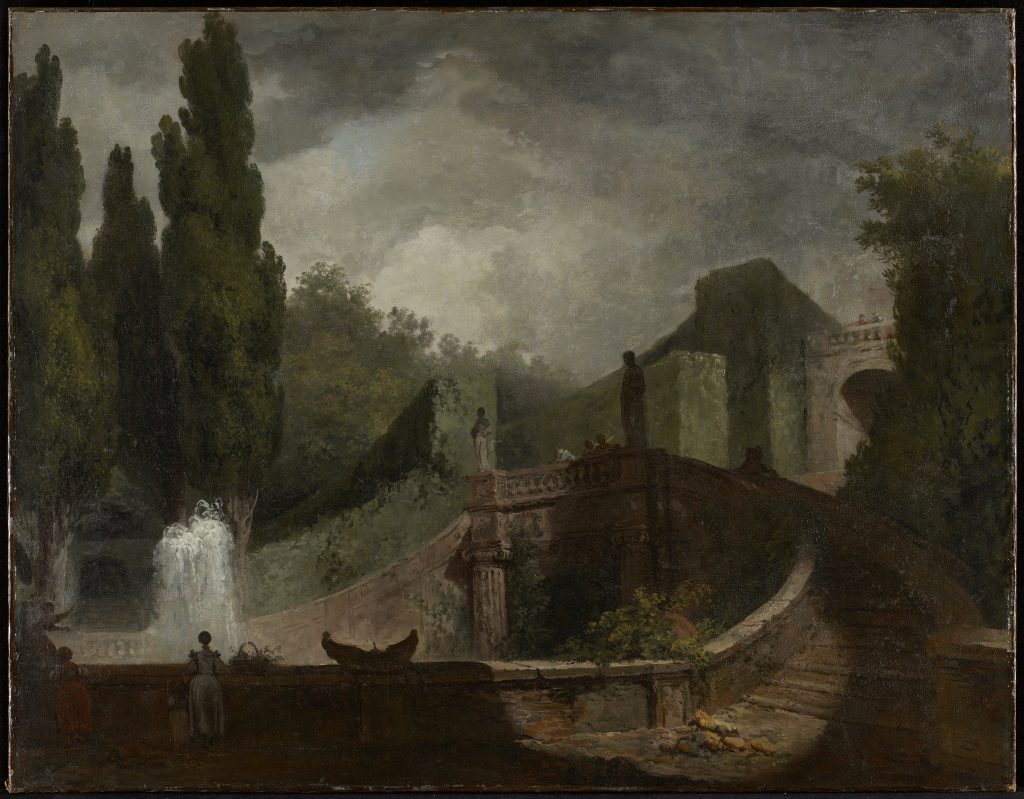
Jean-Honoré Fragonard, The Grand Staircase of the Villa d’Este at Tivoli, ca. 1760, Minneapolis Institute of Art, MN, USA.
Jean-Honoré Fragonard was a talented Rococo artist from France who is most well-known for his romanticized and picturesque depictions in light pastels. In contrast, this painting depicts a more somber mood.
From 1756 until 1761, Fragonard attended the French Academy in Rome. During these years, he spent one summer at the Villa d’Este in Tivoli, about 20 miles west of Rome. This enigmatic villa has been featured in countless mediums of art for its incredible beauty. It had been rented for the season by his patron, Abbé de Saint-Non. The immaculately manicured topiary, tall trees, and remarkably overcast skies occupy most of the composition. Meanwhile, the architectural elements serve as an ornamental focal point. Fragonard featured the iconic grand double circular staircase descending to the Fountain of the Dragons. While the fountain itself isn’t apparent, the mist rising from it is. A few lonely figures appear inconspicuously in the bottom right of the painting.
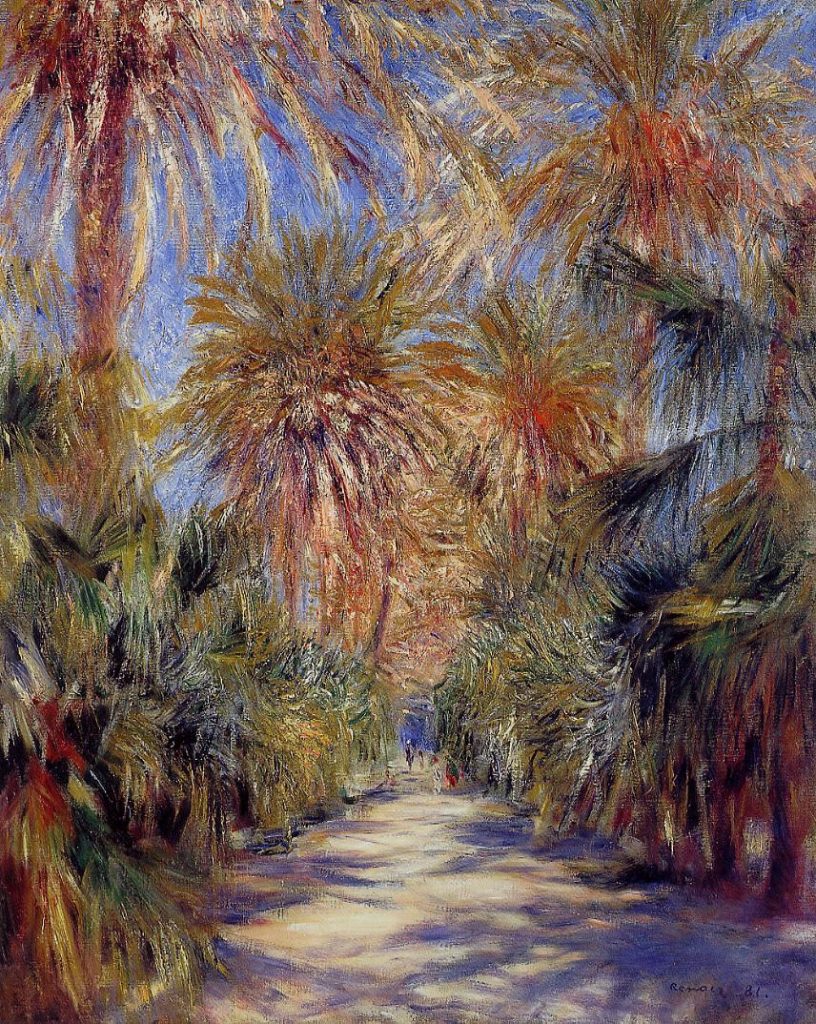
Pierre-Auguste Renoir, Algiers, The Garden of Essai, ca. 1881, private collection, Wikimedia Commons (public domain).
This painting belongs to a series of works inspired by Pierre-Auguste Renoir‘s travels to Algeria. It represents Renoir’s typical landscape style with brilliant colors and loose brushstrokes. Exotic palm trees of all sizes form an allée or lane and their lush canopy casts playful shadows along the path. There is a hint of several figures that promenade in the far distance. Furthermore, the layout in this composition resembles one of his earlier works, In The Woods.
While Renoir was an instrumental figure in the development of Impressionism, this marked the end of his Impressionist journey. In the years that followed, Renoir was increasingly unsatisfied with the Impressionist style and yearned for the more defined silhouettes in classical styles.
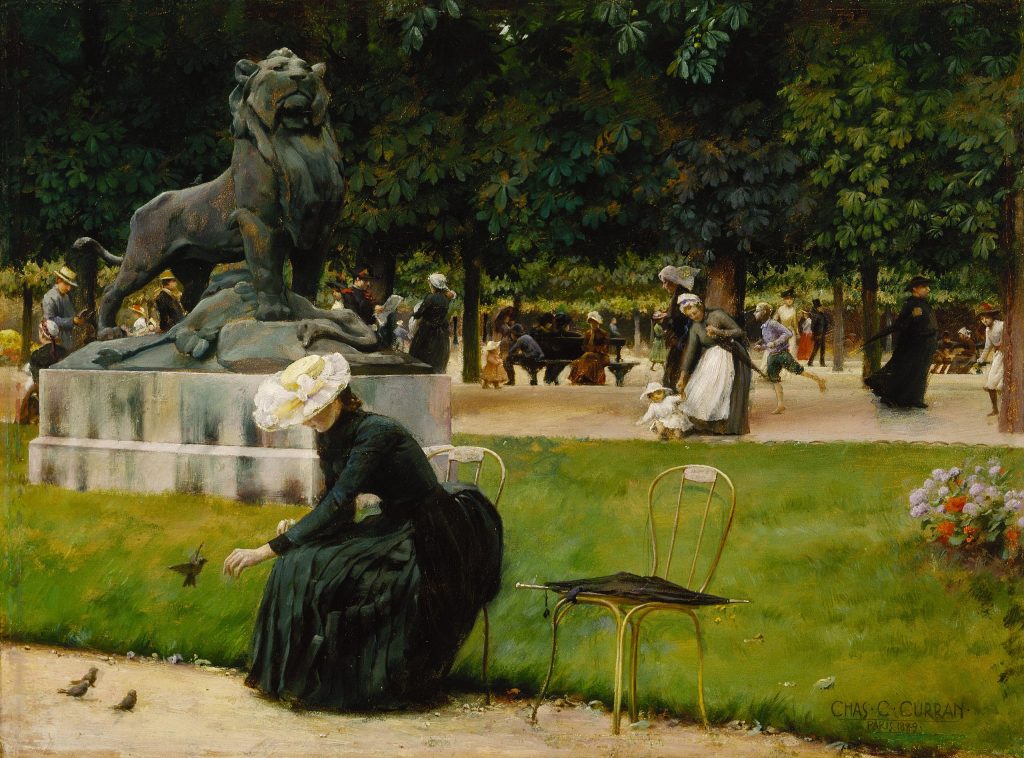
Charles Courtney Curran, In Luxembourg (Garden), ca. 1889, Terra Museum of American Art. Chicago, IL, USA.
Charles Courtney Curran was an American painter in the 19th century. After showing great artistic aptitude at a young age, Curran received formal art training in Cincinnati, New York, and Paris. He spent over two years overseas with his wife and this painting is from his European period. In it, he depicts a lively scene in the Garden of Luxembourg, recognizable by Auguste Cain’s iconic lion sculpture that dominates the background.
A well-dressed woman is the near focus of the composition, along with a noticeably empty seat beside her. She is feeding the birds before her, but the position of her body conveys a hint of melancholy or listlessness. Behind the woman are numerous figures, including children running around and parents tending to them, conveying the liveliness of the day.
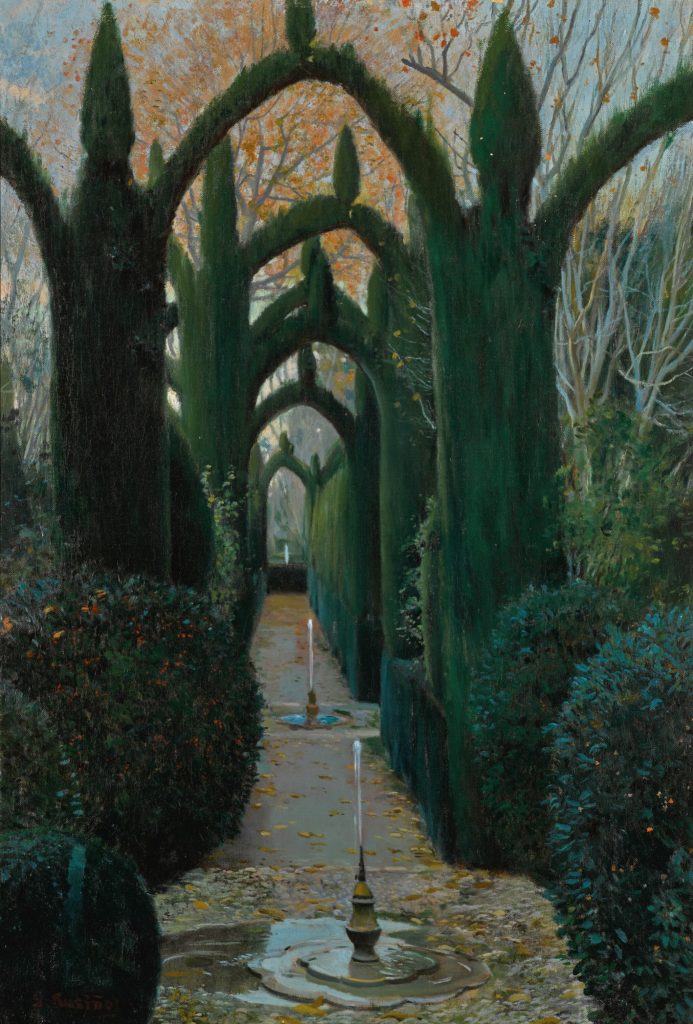
Santiago Rusiñol, The Generalife Gardens, Granada, ca. 1919. Sotheby’s.
Santiago Rusiñol was a prolific painter, draftsman, playwright, novelist, poet, and cultural activist from the late 19th and early 20th centuries. He has been hailed as one of the proponents of modernism in Catalonia. Rusiñol painted canvas after canvas of Catalonia’s breathtaking natural landscape and planned gardens. His later works, such as this painting, were largely devoid of figures and focused on the incredible natural elements and perhaps included a touch of melancholy that was his trademark.
This composition is set in Generalife, the 14th-century summer estate of the Nasrid rulers in Granada, Spain. It presents a view of hedges carved in elaborate, majestic patterns. Trees in the background appear to have dropped their orange leaves into the clearing between the hedges. There are three water features that adorn the spaces in between.
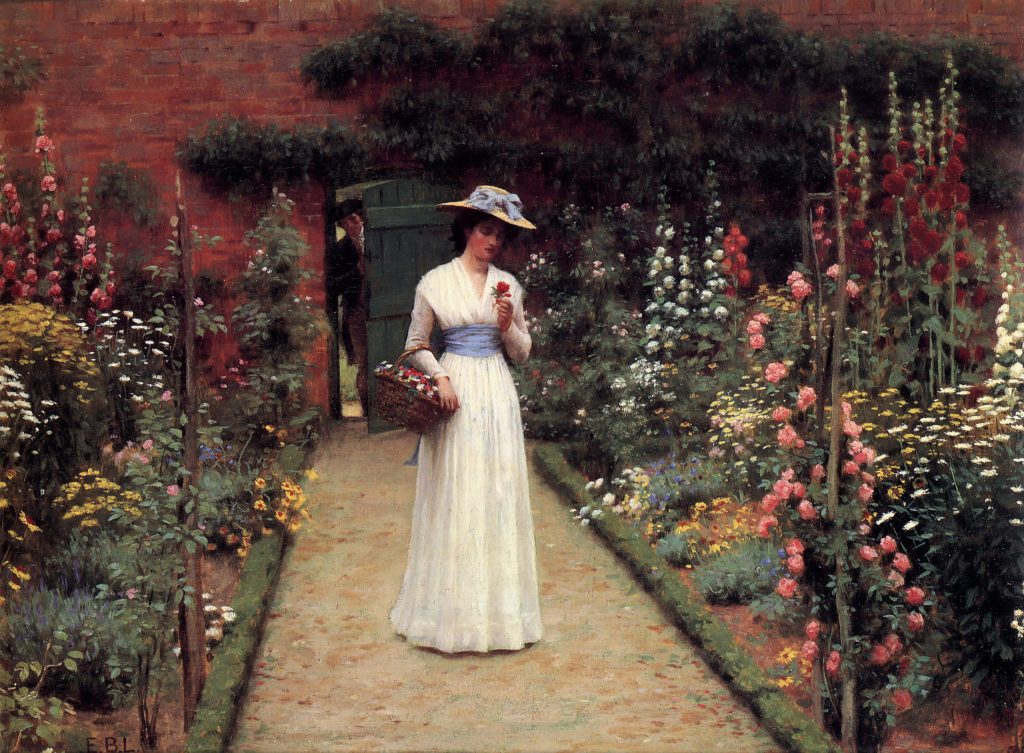
Edmund Blair Leighton, Lady in a Garden. ca. 1906. Wikimedia Commons (public domain).
Edmund Blair Leighton was an English painter known for his romanticized depictions of Victorian themes. Although he never became a member of the Royal Academy, he exhibited his works there for over 40 years. His paintings display his affinity for idealized historical themes and his sitters are often depicted in romantic or chivalrous pursuits.
Picturesque depictions of women in gardens full of flowers were a recurring theme in his artworks and fit his romanticized aesthetic. Here we see a fashionably dressed woman on a garden path with a man holding open a wooden door behind her, as though he is in pursuit of her. The brick wall contrasts with the striking white dress of the woman. There are flowers of all sorts surrounding her but it appears that a singular red rose has her attention.
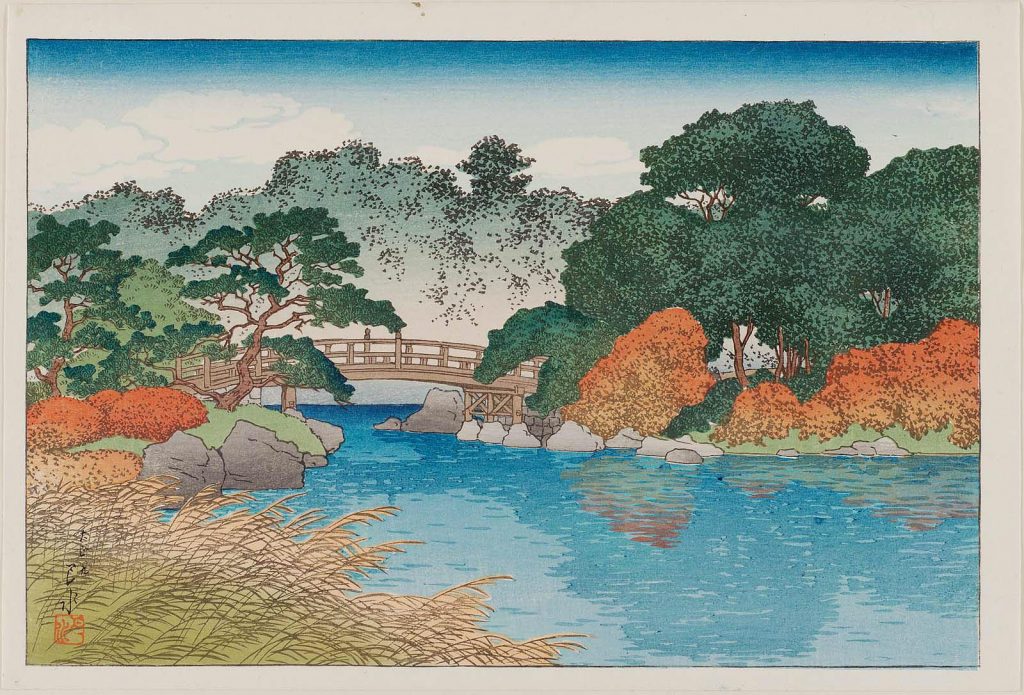
Hasui Kawase, The Garden in Autumn, from an untitled series of views of the Mitsubishi villa in Fukagawa, ca. 1920, Museum of Fine Arts, Boston, MA, USA.
Japanese artist, Hasui Kawase was a leading artist in the shin-hanga or new prints movement that comprised ordinary Japanese subjects depicted in a Western style. Kawase and other ukiyo–e artists were renowned for their peaceful atmospheric compositions that conveyed a great sense of quietude.
The focus of this woodblock print is the quaint wooden bridge suspended over a large body of water at the Mitsubishi villa in Fukagawa. Brilliant shrubbery including the orange bushes hints at autumn. A hint of the flora is reflected in the quiet waters that dominate the lower half of the composition.
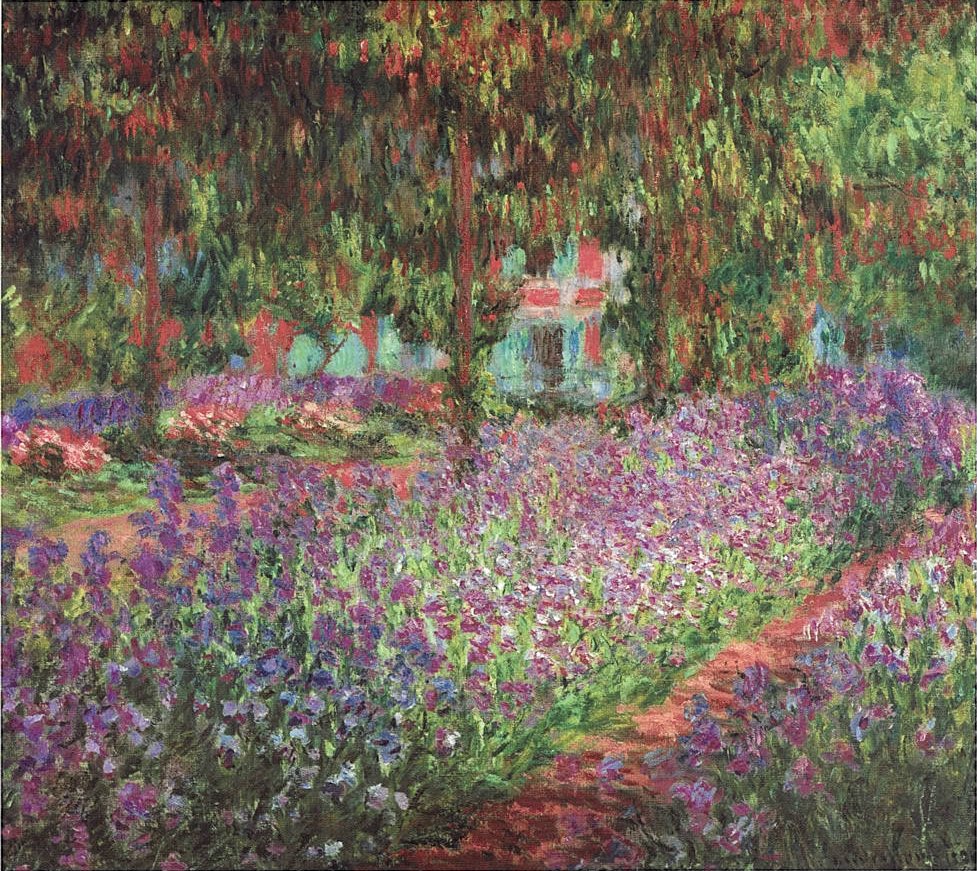
Claude Monet, The Garden of the Painter in Giverny, ca. 1900, Musée d’Orsay, Paris, France.
Claude Monet’s garden in Giverny is a recognizable theme in a large body of his works. He passionately tended to this garden which was overwhelmingly comprised of perennials with some accents of annuals. This painting depicts one of its many breathtaking views and displays row upon row of purple and pink irises illustrated diagonally across the canvas. Large trees cover the upper half of the frame with Monet’s home peeking through the thick foliage.
Monet was 60 years old the year he completed this painting.
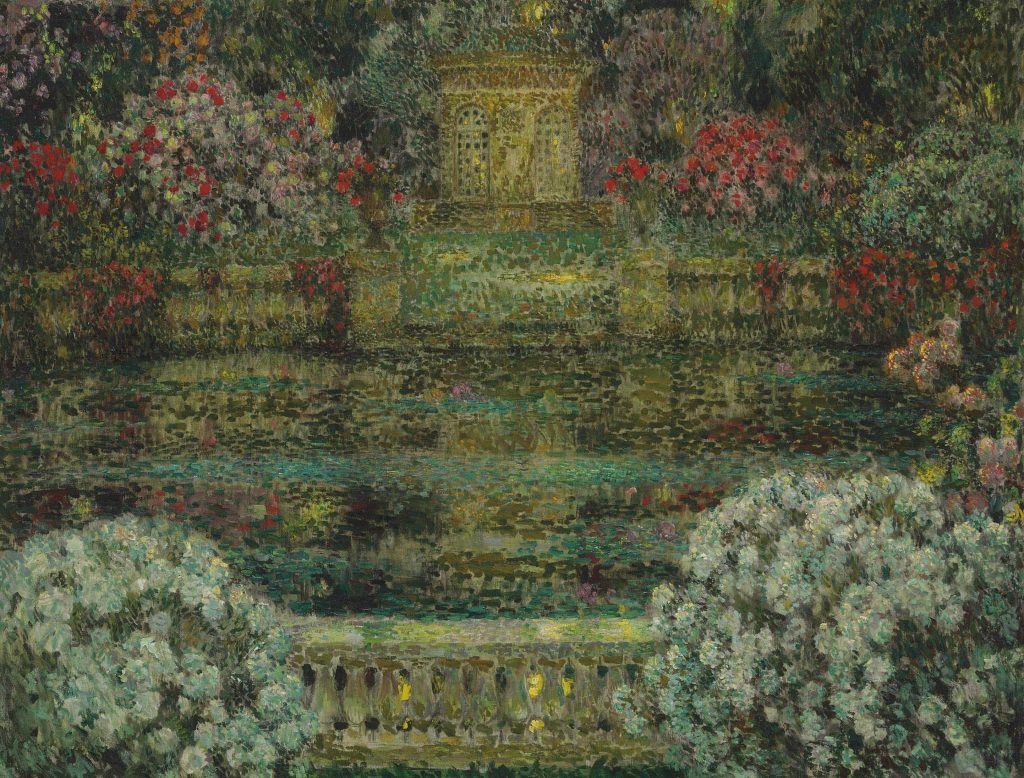
Henri Le Sidaner, Floraison, ca. 1912. Christie’s.
This painting by Henri Le Sidaner was executed in the fall of 1912 in Versailles. Rendered in his trademark atmospheric style, he displays his complete enthrallment with the magnificence of Versailles, where he established residence around 1914. His artistic process constituted conducting careful studies of his subjects and then developing the compositions in his studio. Many of his works depict the dwindling light of dusk that served to highlight the serene interplay of light and shadow. At a glance, his works impart spontaneity however, in reality, they were carefully and meticulously developed.
This painting depicts the warm evening light reflected over the peaceful waters. Carefully orchestrated flowers surround the waters and there is an impression of an architectural structure glowing from the golden light of the waning sun.
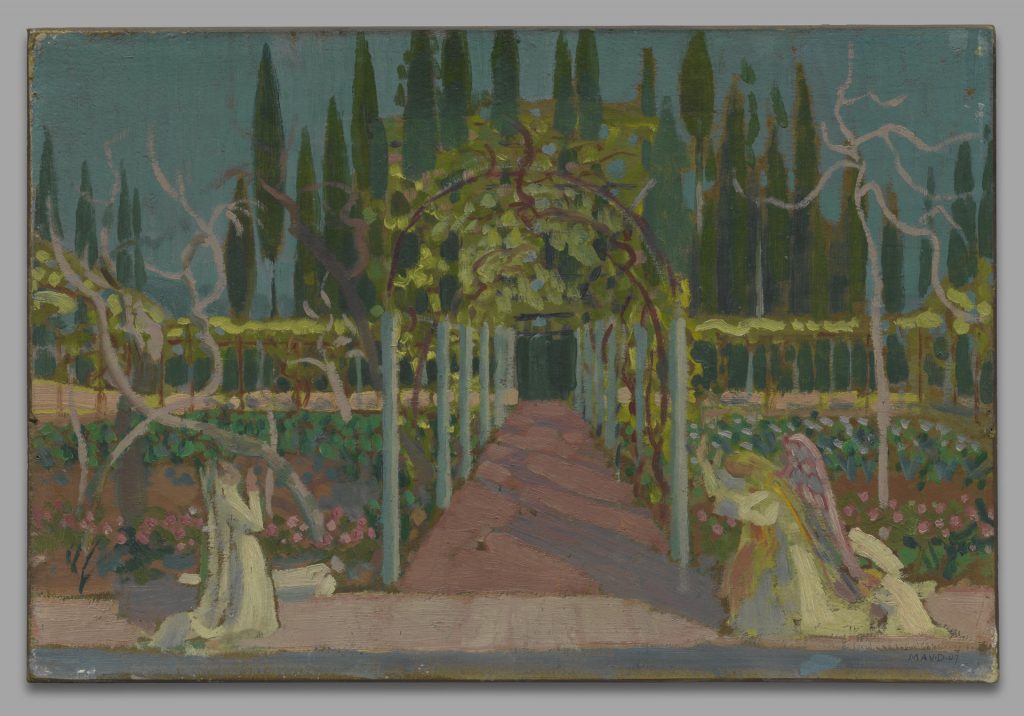
Maurice Denis, Annunciation, ca. 1907, Yale University, New Haven, CT, USA.
Maurice Denis was an accomplished painter and writer in late-19th century France. In his early period, he was a founding member of Les Nabis, however, around the mid-to-late 1890s, he transitioned into a more precise and rigid compositional style that was marked by a religious inclination. Denis was unique among his peers in presenting the synthesis of formal innovation with traditional religious faith.
This painting is Denis’ rendering of the Annunciation to the Virgin Mary, a recurring theme in Christian art. The Annunciation motif celebrates the announcement of the angel Gabriel to the Virgin Mary of the impending birth of Jesus Christ. He depicts the two figures in a picturesque garden with a lush, leafy archway and tall trees scattered in the distance.
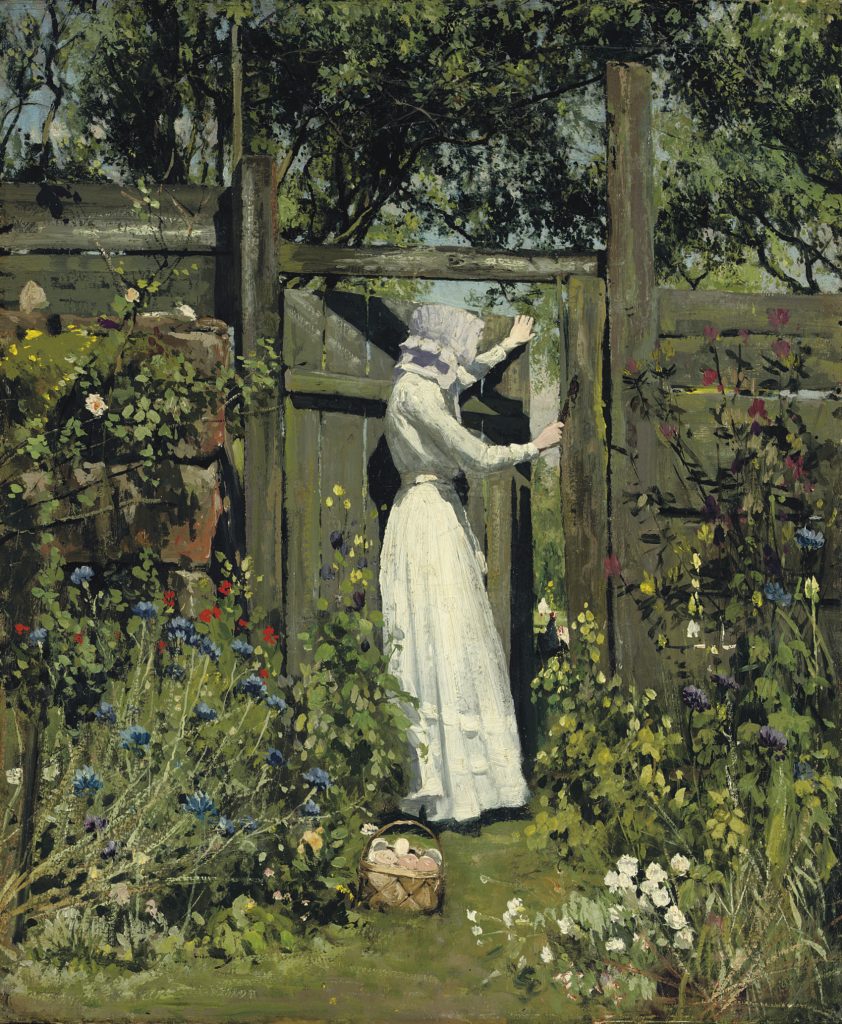
William Page Atkinson Wells, The Lilac Sunbonnet, ca, 1872-1923. Christie’s.
William Page Atkinson Wells was a Glasgow-born artist active in the 19th century. He received formal training at the Slade School of Art in London before spending some years in Australia and France. He eventually moved back to England and settled in the countryside.
In this painting, Wells depicts an overgrown garden full of varying flowers. A basket of eggs sits in the clearing between the flowers. The focal point is a woman dressed in a stark white dress and a lilac bonnet. The white of her dress is brightly illuminated by the strong midday sun beaming down on her, sharply contrasting with the shadows. She holds open a garden gate and her attention is focused on the gate behind her, with perhaps a hint of somebody in the far background. Large trees cover the top of the canvas.
DailyArt Magazine needs your support. Every contribution, however big or small, is very valuable for our future. Thanks to it, we will be able to sustain and grow the Magazine. Thank you for your help!